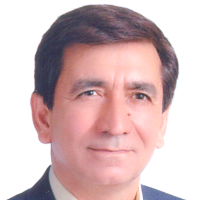The Study of Organic, Chemicaland Biological Fertilizers on Thermal Requirements, Developmental Stages and some of Physiological Indices of Roselle (Hibiscussabdariffa L.) by Irrigation Levels
Author(s):
Article Type:
Research/Original Article (دارای رتبه معتبر)
Abstract:
Introduction
Roselle (Hibiscus sabdarjffaL.) is an annual or biennial plant cultivated in arid and semiarid regions. This plant is grown in parts of Africa, Asia, America and Australia. This plant is ecologically short day, self-pollinated and sensitive to cold and freezing stress. Studies conducted on the medicinal plants in natural ecosystems suggested that using sustainable agriculture system provides the best conditions for the production of these plants, leading to maximum qualitative and quantitative yield in such conditions. In order to analyze the growth indices, leaf area index (LAI) and total dry matter (TDM) is required. Other indices were calculated from LAI and TDM. Considering the importance ofuses andresistant to droughtstress of roselle, this plant cultivate in provinces of Kerman and Fars recently. In order to evaluate the effect of organic, chemical and biological fertilizers on thermal requirements, developmental stages and some of physiological indices of roselle by irrigation levels, was conducted in Jiroft area.Materials And Methods
In orderto evaluate the effect of organic, chemical and biological fertilizers on thermal requirements, developmental stages and some of physiological indices of roselle by irrigation levels, an experiment was conducted at Agricultural Research Farm Jiroft of Universityin2013-2014 growing season. Theexperiment was conducted as strip plot based on a randomized complete blocks design with three replications. Three irrigation regimes (100%, 80% and 60% of crop waterrequirement) were assigned ashorizontal factor and four fertilizer resources (mycorrhiza, vermicompost, cow manure and chemical fertilizer (NPK)) were allocated as vertical factor. Plant water requirement was calculated by using salinity parameters (sensitivity coefficient, salinity threshold and gradient of yield reduction), plant characteristics (height and the maximum depth of root), vegetation coefficients (first, middle and end of growth season), characteristics and duration of growth period with AGWAT software. Then, treatments of 80% and 60% of plant water requirements were determined and irrigation water per irrigation period was recorded by the water meter. As drip irrigation system with 0.001 Sq. M. were independently used for each treatment.Traits such as LAI, TDM, LAD, CGR and RGR indices and dry sepal yield were measured. All data were subjected to analysis of variance (ANOVA) using SAS 9.3 software. When F test indicated statistical significance at PResults And Discussion
The results indicated that roselle is short-day plant and its flowering is stimulated by nearing the short days. Fertilizer resources and irrigation water levels had not significant effect on flowering of plant. Also fertilizer resources and irrigation water levels had significant effect on LAI and TDM. The highest LAD value was found in the cow manure and vermicompost treatments. The highest CGR value was obtained from 100%, 80% and 60% respectively. Growth reduction between irrigation levels 100% and 80% was not significant. Slope decline between irrigation levels (i.e., 100% and 80%) was similar. Slope decline in control and mycorrhizal morethan vermicompost, cow manure and chemical fertilizer. Similar results also reported by Gendy et al., (2012) and Samiran et al., (2010). The results showed that the interaction of Fertilizer resource and levels irrigations on the sepal yield was significant. Sepal yield at all three levels of irrigation showed increase in the plants treated with cow manure, vermicompost and chemical compared with mycorrhizal and control treatment. The highest sepal yield (1217 kg.ha-1) was obtainedfrom100% crop water requirement cow manure treatment and the lowest sepal yield (493 kg.ha-1) was obtained at 60% crop water requirement control treatments.Conclusion
It seems that among the different fertilizer resources, cow manure and vermicompost have a greater impact on soil water holding compared to other sources of fertilizers (mycorrhiza and chemical fertilizer) by increasing soil organic matter. The results of Growth indices analysis, growth degree days and phenology assessment indicated that the most leaf area index and dry matter was observed at flowering stage and the beginning of flowering rosellewas under the influence of photoperiod. Due to soil and climatic conditions of the study area, using cow manure or vermicompost with 80% of the irrigation water requirement, roselle plant seems appropriate.Keywords:
Language:
Persian
Published:
Journal of horticulture science, Volume:32 Issue: 1, 2018
Pages:
93 to 108
magiran.com/p1850712
دانلود و مطالعه متن این مقاله با یکی از روشهای زیر امکان پذیر است:
اشتراک شخصی
با عضویت و پرداخت آنلاین حق اشتراک یکساله به مبلغ 1,390,000ريال میتوانید 70 عنوان مطلب دانلود کنید!
اشتراک سازمانی
به کتابخانه دانشگاه یا محل کار خود پیشنهاد کنید تا اشتراک سازمانی این پایگاه را برای دسترسی نامحدود همه کاربران به متن مطالب تهیه نمایند!
توجه!
- حق عضویت دریافتی صرف حمایت از نشریات عضو و نگهداری، تکمیل و توسعه مگیران میشود.
- پرداخت حق اشتراک و دانلود مقالات اجازه بازنشر آن در سایر رسانههای چاپی و دیجیتال را به کاربر نمیدهد.
In order to view content subscription is required
Personal subscription
Subscribe magiran.com for 70 € euros via PayPal and download 70 articles during a year.
Organization subscription
Please contact us to subscribe your university or library for unlimited access!



